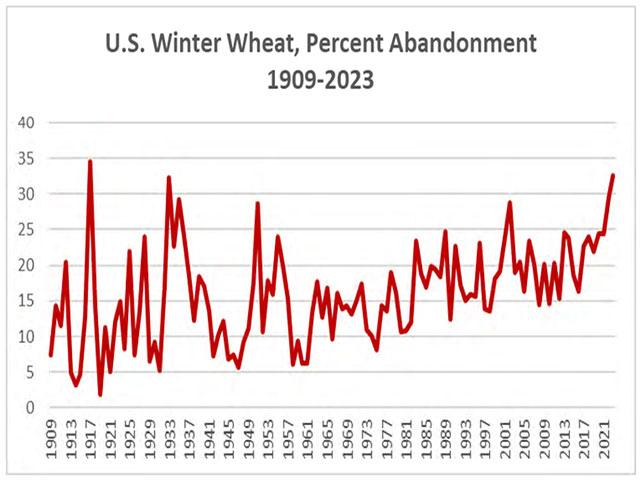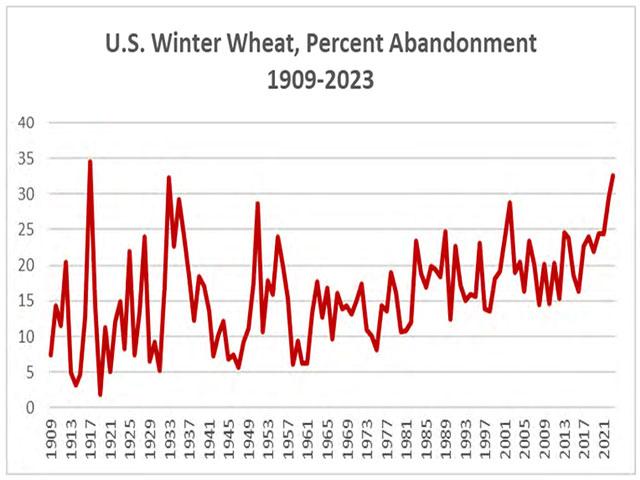Ag Weather Forum
Wheat Abandonment Could Be Most Since World War I
Even as El Nino strengthens in the Pacific Ocean, the effects of its counterpart, La Nina, continue in the form of significant drought impact to the U.S. 2023 winter wheat crop.
USDA's May 14-20 weekly weather and crop bulletin noted that: "Based on preliminary statistics provided by USDA/NASS, U.S. winter wheat abandonment for 2023 is pegged at 32.6%. If realized, this would be the nation's highest winter wheat abandonment rate since 1917. In fact, since abandonment reached 28.6% in 1951, the only years more than one-quarter of the winter wheat was abandoned were 2002, with 28.8%, and 2022, with 29.5%."
Large acreage abandonment has been discussed for months as a possibility, but this estimated percentage deserves additional comment. The USDA estimate suggests that almost 1 out of every 3 acres of winter wheat seeded in the fall of 2022 will be abandoned, likely because of drought. This expected abandonment of almost one-third of seeded acreage surpasses not only the big Southern Plains drought year of 1951, but also exceeds the winter wheat abandonment rate during the Dust Bowl drought years of the 1930s.
P[L1] D[0x0] M[300x250] OOP[F] ADUNIT[] T[]
This issue is especially noteworthy in the Southern Plains. Winter wheat abandonment in Texas is estimated by USDA at 70% and Oklahoma at 53%. In Kansas, USDA's May crop production report suggested a 19% abandonment rate (6.6 million harvested acres versus 8.1 million acres seeded). However, comments from the recent Kansas Wheat Quality tour indicated that the harvested acreage could be lower, possibly in the 5.9-million-acre range. That suggests an abandonment rate of 27% -- more than one-fourth of the original fall 2022 seeded acreage.
What happens now with this expected abandoned acreage? Responses to a social media question about that subject mostly pointed to planting grain sorghum (milo) on abandoned winter wheat ground, to take advantage of a weather pattern change this late spring to more rain. The sorghum planting would offer a cover for the ground along with providing livestock feed either from chopped forage or harvested grain. DTN Lead Analyst Todd Hultman observed that local usage for sorghum on abandoned wheat acreage would be important. "The main concern I have on milo is that I hope they have a good local market for it because milo exports are down sharply (minus 76%) from last year and China is one of the few buyers."
Still, the estimated abandoned winter wheat acreage shows again how the multi-year La Nina Pacific Ocean climate event hammered U.S. hard red winter wheat. Production in 2022, at 530.9 million bushels, was 29% lower than 2021. The latest USDA 2023 hard red winter wheat production estimate is 514.3 million bushels, is 3% lower than 2022 and 31% lower than 2021. High-quality hard red winter wheat supplies remain stifled by the lash of La Nina.
Progressive Farmer Senior Editor Joel Reichenberger's coverage of the Kansas Wheat Quality tour, "Wheat Tour Yield Average Hits 30 BPA," is available here: https://www.dtnpf.com/….
Bryce Anderson can be reached at Bryce.Anderson@dtn.com
Follow him on Twitter @BAndersonDTN
(c) Copyright 2023 DTN, LLC. All rights reserved.






Comments
To comment, please Log In or Join our Community .